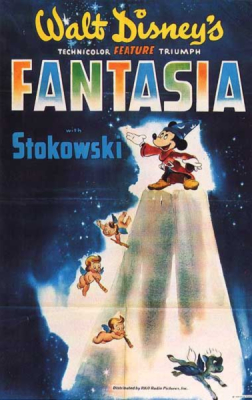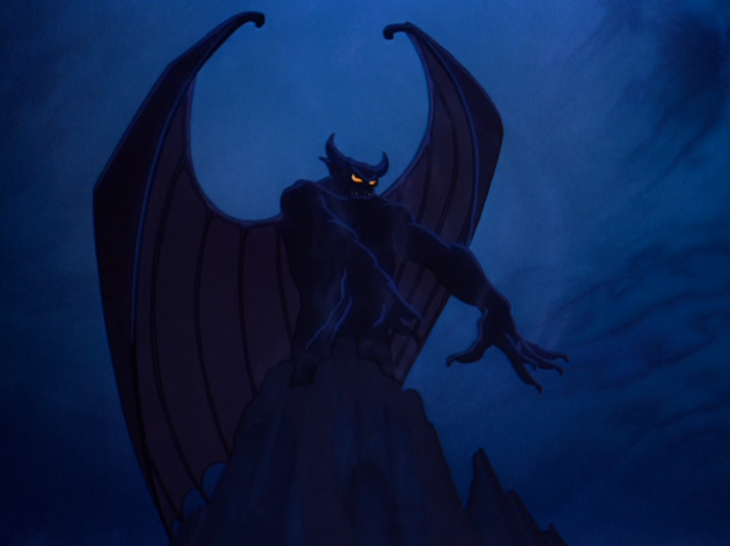 #142- Fantasia (1940)
#142- Fantasia (1940)Starring: Leopold Stokowski, Deems Taylor, The Philadelphia Orchestra
Directed by: Samuel Armstrong, James Algar, Bill Roberts, Paul Satterfield, Ben Sharpsteen, David D. Hand, Hamilton Luske, Jim Handley, Ford Beebe, T. Hee, Norm Ferguson, and Wilfred Jackson
Plot Summary: Disney presents a collection of animated shorts set to classical music, composed by Leopold Stokowski and performed by The Philadelphia Orchestra. Each short tells a different type of story, including a collection of abstract shapes and colors, followed by a representation of the seasons changing with dancing flowers, fairies, and mushrooms. Mickey Mouse is the apprentice of the great sorcerer Yen Sid and attempts to perform some magic by putting on his master's hat. There is then a visual depiction of Earth's beginnings with the dinosaurs, a look at a mythical world from the days of ancient Greece, and a comic ballet comprised of dancing ostriches, elephants, hippos and alligators. The film's grand finale is the dichotomy of light and dark as the devil Chernabog summons spirits and souls from their graves until the light shines through as night fades into dawn.
There was a point in Disney's earlier years where a majority of their animated films were compiled of their animated shorts. That trend began with Fantasia, a collection of animated shorts set to classical music. There's a specific mindset that must accompany a film like this. That mindset is to watch and appreciate the film not only on an animated level, but on a musical level as well. I knew going into this movie that what would make the film work, or not work, was if the two elements would be able to blend together perfectly for each individual short.
"Toccata and Fugue in D Minor" by Johann Sebastian Bach is the film's first short, and it is set to a collection of abstract shapes and colors. It's an effective way to start the film, serving as a warm up of things to come. It also is a concept that I'm sure many people can imagine when listening to music, letting your mind create random images to accompany the music. Pyotr Ilyich Tchaikovsky's "Nutcracker Suite" is the centerpiece of a short about the changing of the seasons. Through a collection of fairies, flowers, mushrooms, and fish set do a different song each, the seasons are able to transition on point with the songs. It's a fun musical number that instills a proper amount of creativity through its imagery.
 "The Sorcerer's Apprentice" by Paul Dukas is the centerpiece of the film, and probably the short most people associate with Fantasia. Mickey Mouse plays the sorcerer's apprentice and the short revolves around him trying to do the magic he sees his master perform. It's one of the more famous pieces of Disney animation and a piece that revitalized Mickey's career (he was losing popularity at the time). What's interesting to note about the music for the short is that it was written specifically to fit with the original story, a poem written by Goethe. That way, when we see it featured in this animated short, each action is meant to go along with the music, creating a mixture of animation and music that go hand in hand.
"The Sorcerer's Apprentice" by Paul Dukas is the centerpiece of the film, and probably the short most people associate with Fantasia. Mickey Mouse plays the sorcerer's apprentice and the short revolves around him trying to do the magic he sees his master perform. It's one of the more famous pieces of Disney animation and a piece that revitalized Mickey's career (he was losing popularity at the time). What's interesting to note about the music for the short is that it was written specifically to fit with the original story, a poem written by Goethe. That way, when we see it featured in this animated short, each action is meant to go along with the music, creating a mixture of animation and music that go hand in hand.If there were any weak spots, I'd say it would be in the middle of the film. Igor Stravinsky's "The Rite of Spring," Ludwig van Beethoven's "The Pastoral Symphony," and Amilcare Ponchielli's "Dance of the Hours" accompany shorts where the music doesn't exactly add up the way you'd hope. "The Rite of Spring" focuses on how the world was created and while a bit dark and serious, it can also be a tad boring to watch. "The Pastoral Symphony" goes on and on with numerous false endings, making it annoying when it persists to tell its story (although, props to them for creating a continuity of how their ancient mythology looks, with many designs reminiscent of Hercules). "Dance of the Hours" is just bizarre with numerous animals dancing. It's the most "Disney" looking of the shorts, and that actually hurts it since the other shorts at least look like they're trying to be something different from what we expect from Disney. Instead of blending well together, the shorts begin to drag and you almost can't wait for them to be over, even if the animation looks nice and the music sounds beautiful.
The film ends on a very high note with its depictions of Modest Mussorgsky's "Night on Bald Mountain" and Franz Schubert's "Ave Maria." It's a great combination of one of the darkest moments you'll ever see from Disney, as well as one of the most beautiful. This one's so good, I think it'll be better to see it for yourself, instead of me trying to describe all of it to you. But trust me when I say it's worth checking out, and it's quite possibly the best spot in the film because it serves as the proper way the film should end.
Fantasia should be looked at as a revolutionary concept from Disney. It was able to take their beloved animated style and combine it with some of the greatest pieces of classical music, introducing and attracting the style of music to a younger demographic in the process. This film started the trend of Disney's package films, but it proved to be a very difficult task to re-create the magic they were able to bring to the screen with Fantasia.
Rating: 4 out of 5 stars
Some of the shorts are lacking that spark to keep the film's momentum going, but Fantasia is still a fun film with enough beautiful and entertaining moments for fans of music and animation. It's a film worth checking out for a weekend rental for all those Disney fans out there.
Comment below to share your thoughts on the movie or to discuss a topic that I left out of my review
Fantasia and movie images are copyrighted by Walt Disney Pictures

No comments:
Post a Comment